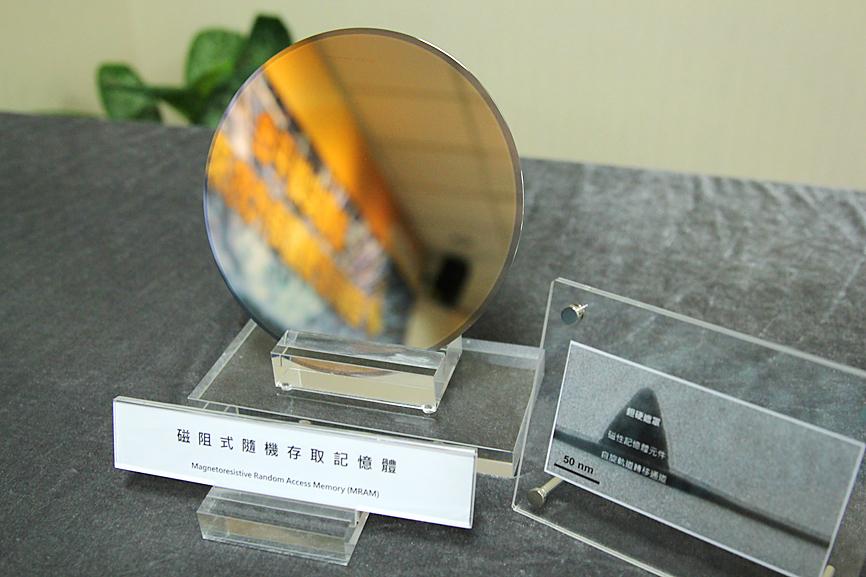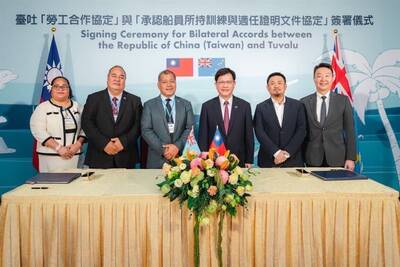The Taiwan Semiconductor Research Institute (TSRI) yesterday unveiled a new memory device it developed with university researchers, saying that they are the world’s second team after Intel to make the breakthrough.
Magnetoresistive random access memory (MRAM) is widely regarded as having the potential to become a mainstream device, TSRI Fabrication Service Division director Li Kai-shin (李愷信) told a news conference in Taipei.
To develop the device, global manufacturers have been working on various techniques, including spin-transfer-torque MRAM (STT-MRAM) and spin-orbit-torque MRAM (SOT-MRAM), although SOT-MRAM is still mostly in the research phase, he said.

Photo courtesy of the National Applied Research Laboratories
The institute has worked with local researchers to develop a SOT-MRAM device that can read data faster, while consuming less energy and undergoing any number of operations, than an STT-MRAM device, he said.
Their key breakthrough came by using a challenging technique called perpendicular magnetic anisotropy (PMA) to turn the magnetic poles vertically within the device, enabling them to develop a memory device that is smaller, he said.
After Intel, they are only the world’s second team to have achieved the breakthrough, Li said, adding that they published their findings in a paper for the Symposium on VLSI Technology and Circuits in June.
The manufacturing process involves the structuring of more than 30 layers of film, each of which only measures 0.4 nanometers, he said.
While Intel did not reveal the structural features of its device, the team clarified the physical mechanism involved in making the device, he added.
Other team members include National Tsing Hua University materials science and engineering professor Lai Chih-huang (賴志煌), National Taiwan University electrical engineering professor Liu Chee-wee (劉致為) and researchers at the Industrial Technology Research Institute (工業技術研究院).
The institute’s key equipment for developing MRAM include a physical vapor deposition system purchased from US firm Applied Materials and an etching system purchased from Japan, Li said.
Compared with semiconductor firms, the institute’s facilities might not contain the most state-of-the-art equipment, but students have learned through trial and error, and are prepared to work in the chip industry, Liu said.
The team’s breakthrough is significant, but it is difficult to say when the SOT-MRAM device might enter mass production, TSRI Deputy Director-General Shieh Jia-min (謝嘉民) said.
Asked whether the technique would be transferred to domestic manufacturers, Shieh said that it takes time for technology transfers, although the team hopes to engage with more local equipment and materials suppliers.
Based at the Hsinchu Science Park (新竹科學園區) with facilities in Tainan, TSRI is one of the eight laboratories under the National Applied Research Laboratories (NARL).
British Representative to Taiwan John Dennis met with NARL President Wu Kuang-chong (吳光鐘) to discuss semiconductor research and development in Taiwan, expressing the hope that the UK and Taiwan could expand their cooperation in tech-related industries, the British Office Taipei wrote on Facebook on Thursday.

The Ministry of Economic Affairs has fined Taobao NT$1.2 million (US$36,900) for advertisements that exceeded its approved business scope and ordered the Chinese e-commerce platform to make corrections in the first half of this year or its license would be revoked. Lawmakers have called for stricter supervision of Chinese e-commerce platforms and more stringent measures to prevent China from laundering its goods through Taiwan as US President Donald Trump’s administration cracks down on origin laundering. The legislature’s Finance Committee yesterday met to discuss policies to prevent China from dumping goods in Taiwan, inviting government agencies to report on the matter. Democratic Progressive Party

Taiwan and its Pacific ally Tuvalu on Tuesday signed two accords aimed at facilitating bilateral cooperation on labor affairs, according to Taiwan’s Ministry of Foreign Affairs (MOFA). The governments inked two agreements in Taipei, witnessed by Foreign Minister Lin Chia-lung (林佳龍) and visiting Deputy Tuvaluan Prime Minister Panapasi Nelesone, MOFA said in a news release. According to MOFA, the agreements will facilitate cooperation on labor issues and allow the two sides to mutually recognize seafarers’ certificates and related training. Taiwan would also continue to collaborate with Tuvalu across various fields to promote economic prosperity as well as the well-being of their

The Taipei District Prosecutors’ Office has continued its investigation into allegations of forged signatures in recall efforts today by searching the Chinese Nationalist Party’s (KMT) city chapter and questioning several personnel including the chapter director, according to media reports. Among those questioned and detained were KMT Taipei chapter director Huang Lu Chin-ju (黃呂錦茹), chapter secretary-general Chu Wen-ching (初文卿), chapter secretary Yao Fu-wen (姚富文) and first district committee executive director Tseng Fan-chuan (曾繁川). Prosecutors said they would not confirm reports about who had been summoned. The investigation centers on allegations that the ongoing recall campaigns targeting Democratic Progressive Party legislators Rosalia Wu (吳思瑤)

Taiwan would welcome the return of Honduras as a diplomatic ally if its next president decides to make such a move, Minister of Foreign Affairs Lin Chia-lung (林佳龍) said yesterday. “Of course, we would welcome Honduras if they want to restore diplomatic ties with Taiwan after their elections,” Lin said at a meeting of the legislature’s Foreign Affairs and National Defense Committee, when asked to comment on statements made by two of the three Honduran presidential candidates during the presidential campaign in the Central American country. Taiwan is paying close attention to the region as a whole in the wake of a